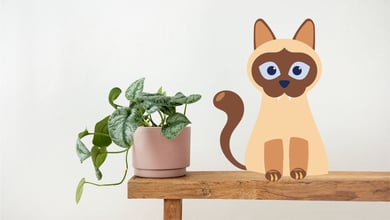10 Cat Facts That Will Leave You Kneading More

Cats are special pets that have been domesticated for thousands of years. While many of us are familiar with some of the quirks that come with living with and loving your pet cat, there are some surprising and quirky cat facts that you might not know. We’ll explore 10 facts that make us love cats even more, and some tips for caring for them.
Facts About Cat Anatomy
1. Cats Can Jump Up to Six Times Their Body Length
As cat parents probably already know, most cats are very athletic, and one of their most impressive abilities is their jumping power. Most cats can jump up to six times their body length, which is due in part to their strong legs and flexible spine.
2. Cats Have an Extra Organ that Helps Them Taste
While humans have about 9,000 taste buds, cats only have around 470. However, cats have an extra organ in their mouth called the Jacobson's organ, or vomeronasal organ, located inside the nasal cavity and the roof of the mouth, which helps them taste and smell things that are not detected by the normal taste buds.
3. Cats Can’t Taste Sweetness
While cats do have a strong sense of taste, they are not able to taste sweetness. This is because cats are carnivores and thrive on a meat-based diet, and they are not biologically able to taste sugar.
4. Cats Have an Amazing Sense of Balance
Cats are famous for their amazing sense of balance, and have what’s called a righting reflex and and a very flexible spine, which allows them to twist their bodies in mid-air to land on their feet. The righting reflex can be observed in kittens as young as 3 weeks old, and by 7 weeks, this skill is fully developed.
Facts About Cat Health
5. Cats Can Get Asthma
Just like humans, cats can suffer from asthma. Asthma is a condition that causes the airways to become inflamed and narrowed, making it difficult for a cat to breathe. If your cat is wheezing, coughing, or having trouble breathing, you should consult with your veterinarian, as they may be suffering from asthma.
6. Cats Can Get Sunburned
It may sound unbelievable, as most cats have fur to protect their skin, but they can still get sunburned. While rare, cats with light-colored or thin fur and hairless cats are more susceptible. If your cat falls into one of these categories and spends a lot of time in the sun, be sure to provide plenty of shade and speak to your veterinarian about other methods to protect them.
7. Cats Sleep Up to 16 Hours a Day
Cats are famous for their love of sleep, and they can sleep for up to 16 hours a day. This is because cats are natural predators, and their sleeping patterns allow them to conserve energy for hunting. Lethargy can also be a sign that your cat is not feeling well, so if they seem sleepier than normal or have lost interest in their usual activities, you should reach out to your veterinarian.
Fun Facts About Cats
8. A Group of Cats is Called a Clowder
Just like a group of dogs is called a pack, a group of cats is called a clowder. Other nouns used to refer to groups of cats include a glaring of cats or a kindle of kittens.
9. Cats Were Worshipped in Ancient Egypt
In ancient Egypt, cats were considered magical and were worshipped as gods. Because they were viewed as sacred, it was a crime to harm a cat and they were even dressed in jewels. Cats of wealthy families were mummified and buried with their owners.
10. Cats Can Purr at Different Frequencies
We all know that cats purr when they are happy, but did you know that they can purr at different frequencies? Cats can purr at a range of frequencies between 25 and 150 hertz (a unit of frequency equal to one cycle per second) which is believed to have therapeutic benefits and can even help them heal faster.
Frequently Asked Questions
Do cats always land on their feet?
Cats have an innate sense of balance referred to as a “righting reflex” that allows them to twist their bodies in the air and land on their feet. Depending on the height of the fall, cats will not always land on their feet and still have the potential to be injured from a fall.
Why do cats purr?
Cats and kittens most often purr because they are feeling happy and content. Cats may also purr when they are hungry or want something, and some even purr when they are in pain. Why would a cat purr when they are in pain? Some research shows that, in addition to being self-soothing, purring actually has a healing effect.
Why does my cat sleep on my head or face?
Our heads are usually one of the warmest places on our bodies and cats are drawn to our body heat. It is also thought to be a sign of affection and a way to bond with you. One possible solution is to provide a warm and cozy pet bed right next to you as an alternative.
Why do cats knead?
Kittens knead while they are nursing from their mother, and this learned behavior can also be a way for kittens and cats to relax. Another theory is that cat kneading is an example of nesting behavior, to create a comfortable place to sleep or to mark their territory with the scent glands in their paws.
Conclusion
Cats make excellent pets, and with their special physical features, playfulness, and athletic ability, cats will always be a source of entertainment. The 10 fascinating facts above are just some of the many reasons why we love them. Have other questions about your cat’s health or behavior? Our mobile veterinarians have observed many cats in their home environment and are here to help!







